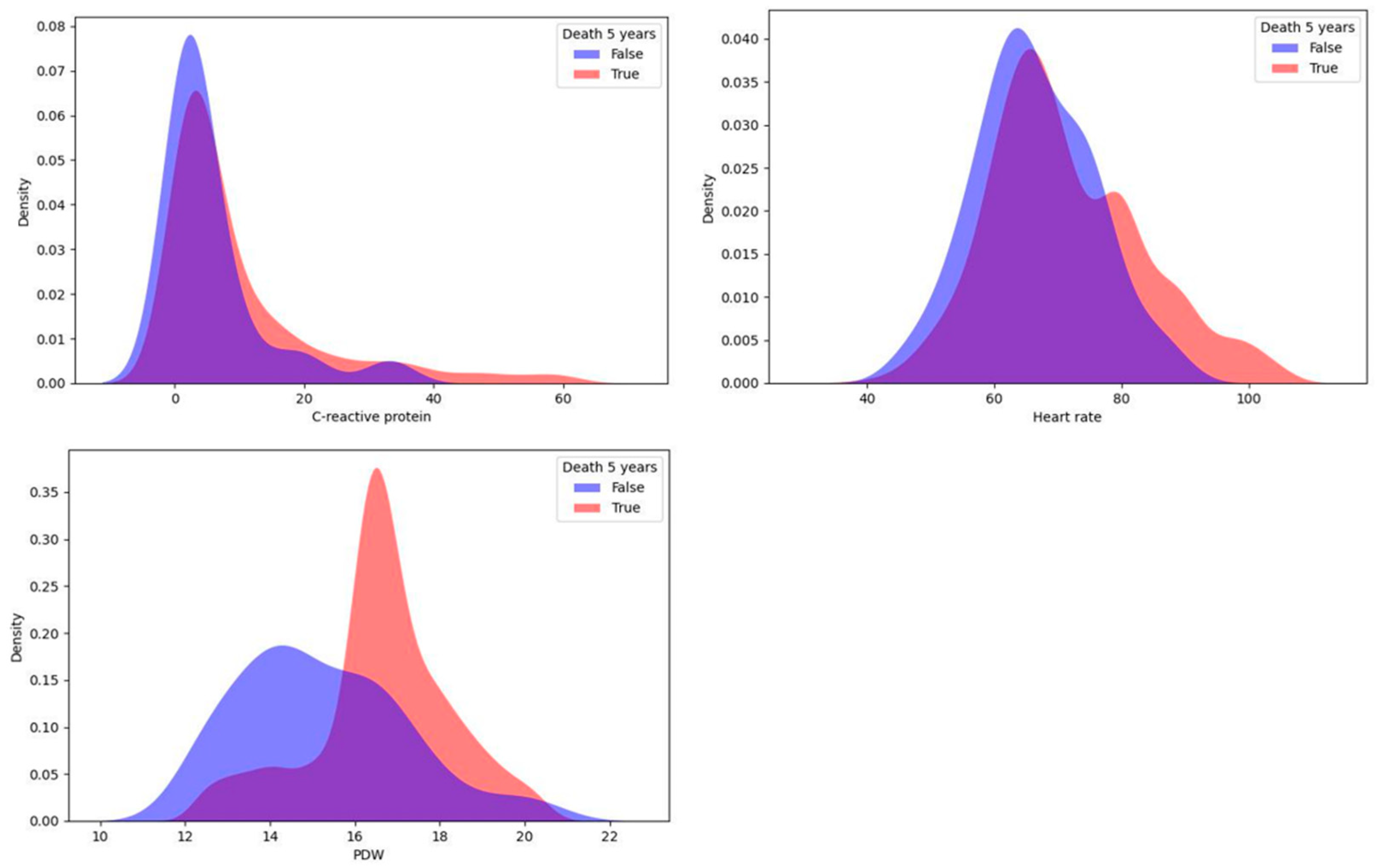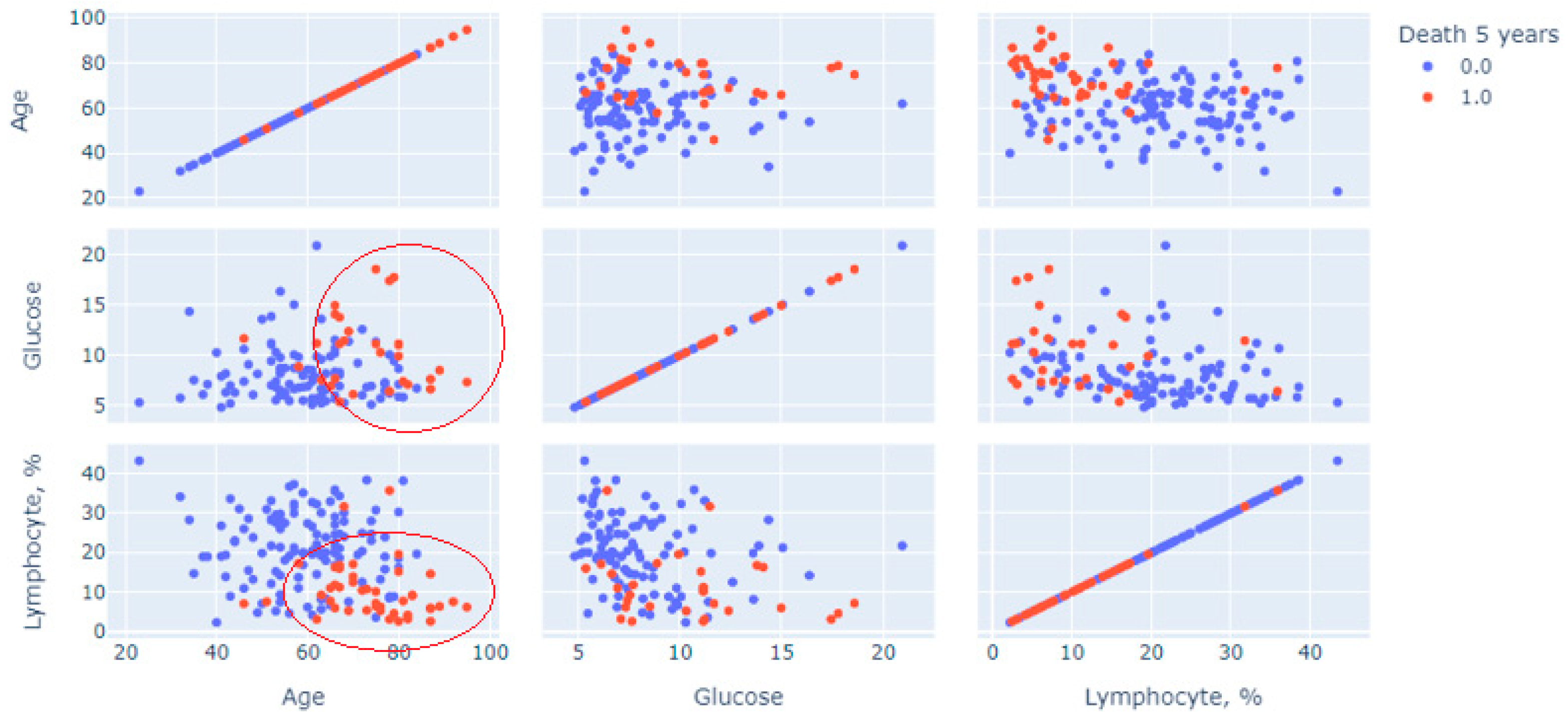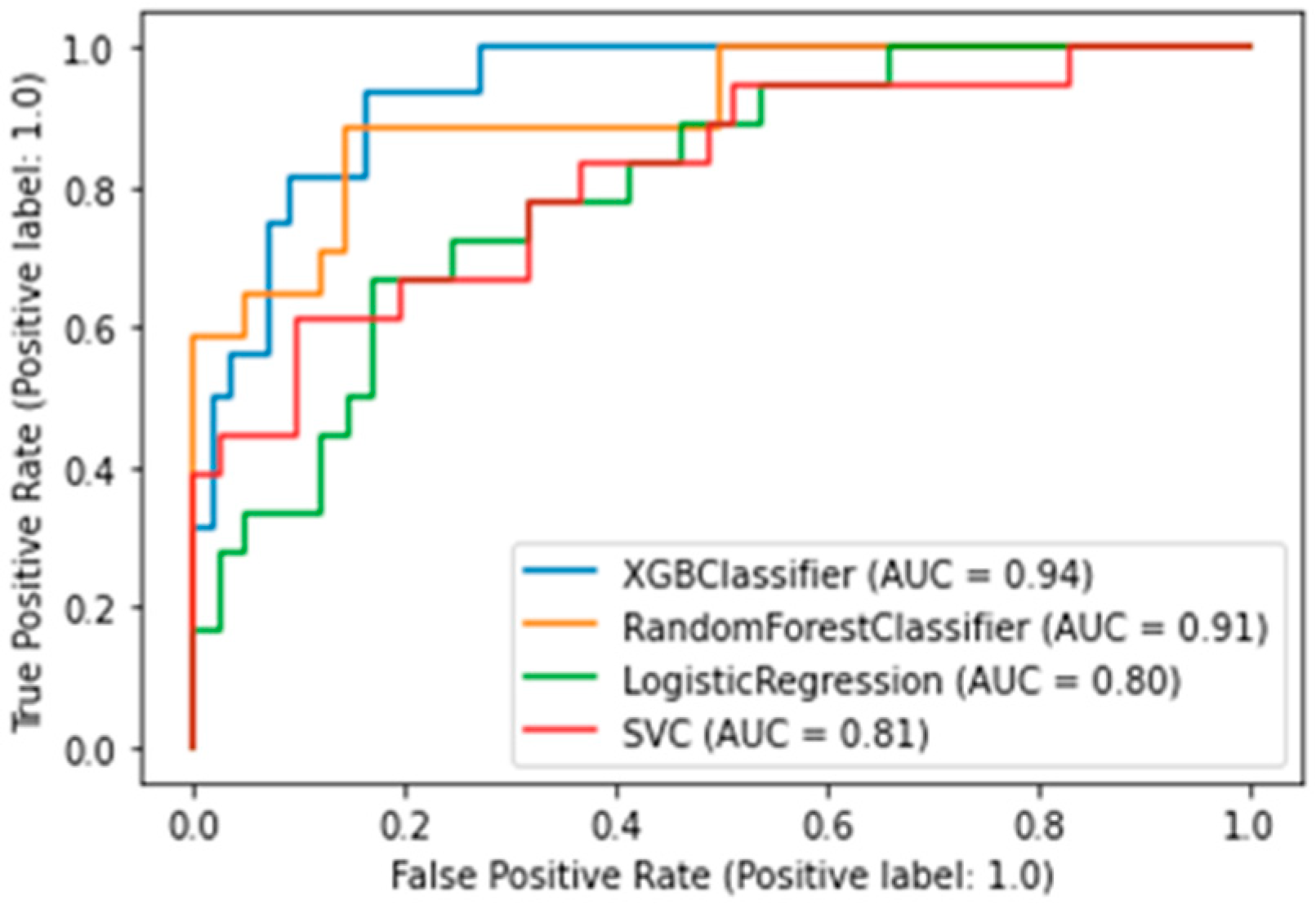Predictors of Carbohydrate Metabolism Disorders and Lethal Outcome in Patients after Myocardial Infarction: A Place of Glucose Level
Abstract
1. Introduction
2. Materials and Methods
2.1. Patients
2.2. Data Collection
2.3. Statistical Analysis
2.4. Plan of the Study
- 1.
- Unloading the data from the database;
- 2.
- Unification, cleaning, and standardization of information;
- 3.
- Extraction of indicators from medical texts (anamnesis, diagnoses, etc.);
- 4.
- Selection of patients with developed endpoints within 5 years;
- 5.
- Selection of patients who visited specialists for 5 years;
- 6.
- Selection of patients without type 2 diabetes mellitus and lethal outcome over 5 years.
- 1.
- Filling in data omissions;
- 2.
- Value aggregation;
- 3.
- Class balancing;
- 4.
- Coding of categorical variables.
- 1.
- Statistical hypothesis testing;
- 2.
- Univariate statistical analysis;
- 3.
- Multivariate statistical analysis;
- 4.
- Selection of statistical patterns and predictors for modeling.
- 1.
- Construction of initial models;
- 2.
- Selection of attributes based on models;
- 3.
- Selection of models;
- 4.
- Interpretation;
- 5.
- Validation.
3. Results
3.1. Exploratory Data Analysis
3.2. Mortality Prediction Modelling
3.3. CMD Prediction Modelling
4. Discussion
5. Conclusions
Author Contributions
Funding
Institutional Review Board Statement
Informed Consent Statement
Data Availability Statement
Conflicts of Interest
References
- American Diabetes Association. Standards of Medical Care in Diabetes—2022 Abridged for Primary Care Providers. Clin. Diabetes 2022, 40, 10–38. [Google Scholar] [CrossRef]
- Crandall, J.P.; Mather, K.; Rajpathak, S.N.; Goldberg, R.B.; Watson, K.; Foo, S.; Ratner, R.; Barrett-Connor, E.; Temprosa, M. Statin use and risk of developing diabetes: Results from the Diabetes Prevention Program. BMJ Open Diabetes Res. Care 2017, 5, e000438. [Google Scholar] [CrossRef]
- Vedantam, D.; Poman, D.S.; Motwani, L.; Asif, N.; Patel, A.; Anne, K.K. Stress-induced hyperglycemia: Consequences and management. Cureus 2022, 14, e26714. [Google Scholar] [CrossRef]
- Capes, S.E.; Hunt, D.; Malmberg, K.; Gerstein, H.C. Stress hyperglycaemia and increased risk of death after myocardial infarction in patients with and without diabetes: A systematic overview. Lancet 2000, 355, 773–778. [Google Scholar] [CrossRef]
- Schiele, F.; Descotes-Genon, V.; Seronde, M.F.; Blonde, M.C.; Legalery, P.; Meneveau, N.; Ecarnot, F.; Mercier, M.; Penfornis, A.; Thebault, L.; et al. Predictive value of admission hyperglycaemia on mortality in patients with acute myocardial infarction. Diabet Med. 2006, 23, 1370–1376. [Google Scholar] [CrossRef]
- Moghissi, E.S.; Korytkowski, M.T.; DiNardo, M.; Einhorn, D.; Hellman, R.; Hirsch, I.B.; Inzucchi, S.E.; Ismail-Beigi, F.; Kirkman, M.S.; Umpierrez, G.E. American Association of Clinical Endocrinologists and American Diabetes Association Consensus Statement on Inpatient Glycemic Control. Diabetes Care 2009, 32, 1119–1131. [Google Scholar] [CrossRef]
- American Diabetes Association. Diabetes Care in the Hospital. Sec. 13. of Standards of Medical Care in Diabetes-2022. Diabetes Care 2022, 45 (Suppl. S1), S244–S253. [Google Scholar] [CrossRef] [PubMed]
- Umpierrez, G.E.; Isaacs, S.D.; Bazargan, N.; You, X.; Thaler, L.M.; Kitabchi, A.E. Hyperglycemia: An independent marker of in-hospital mortality in patients with undiagnosed diabetes. J. Clin. Endocrinol. Metab. 2002, 87, 978–982. [Google Scholar] [CrossRef] [PubMed]
- Ishihara, M.; Inoue, I.; Kawagoe, T.; Shimatani, Y.; Kurisu, S.; Hata, T.; Nakama, Y.; Kijima, Y.; Kagawa, E. Is admission hyperglycaemia in non-diabetic patients with acute myocardial infarction a surrogate for previously undiagnosed abnormal glucose tolerance? Eur. Heart J. 2006, 27, 2413–2419. [Google Scholar] [CrossRef] [PubMed]
- Usami, M.; Sakata, Y.; Nakatani, D.; Suna, S.; Matsumoto, S.; Hara, M.; Kitamura, T.; Ueda, Y.; Iwakura, K.; Sato, H.; et al. Clinical impact of acute hyperglycaemia on development of diabetes mellitus in non-diabetic patients with acute myocardial infarction. J. Cardiol. 2014, 63, 274–280. [Google Scholar] [CrossRef]
- Bronisz, A.; Kozinski, M.; Magielski, P.; Fabiszak, T.; Bronisz, M.; Swiatkiewicz, I.; Sukiennik, A.; Beszczynska, B.; Junik, R.; Kubica, J. Stress hyperglycaemia in patients with first myocardial infarction. Int. J. Clin. Pract. 2012, 66, 592–601. [Google Scholar] [CrossRef]
- Shore, S.; Borgerding, J.A.; Gylys-Colwell, I.; McDermott, K.; Ho, P.M.; Tillquist, M.N.; Lowy, E.; McGuire, D.K.; Stolker, J.M.; Arnold, S.V.; et al. Association between hyperglycaemia at admission during hospitalization for acute myocardial infarction and subsequent diabetes: Insights from the veterans administration cardiac care follow-up clinical study. Diabetes Care 2014, 37, 409–418. [Google Scholar] [CrossRef]
- Laakso, M.; Zilinskaite, J.; Hansen, T.; Boesgaard, T.W.; Vänttinen, M.; Stancáková, A.; Jansson, P.A.; Pellmé, F.; Holst, J.J.; Kuulasmaa, T.; et al. EUGENE2 Consortium. Insulin sensitivity, insulin release and glucagon-like peptide-1 levels in persons with impaired fasting glucose and/or impaired glucose tolerance in the EUGENE2 study. Diabetologia 2008, 51, 502–511. [Google Scholar] [CrossRef]
- Wallander, M.; Bartnik, M.; Efendic, S.; Hamsten, A.; Malmberg, K.; Ohrvik, J.; Ohrvik, J.; Rydén, L.; Silveira, A.; Norhammar, A. Beta cell dysfunction in patients with acute myocardial infarction but without previously known type 2 diabetes: A report from the GAMI study. Diabetologia 2005, 48, 2229–2235. [Google Scholar] [CrossRef]
- Yuan, K.; Cheng, X.; Gui, Z.; Li, F.; Wu, H. A quad-tree-based fast and adaptive Kernel Density Estimation algorithm for heat-map generation. Int. J. Geogr. Inf. Sci 2019, 33, 2455–2476. [Google Scholar] [CrossRef]
- Henein, M.Y.; Lindqvist, P. Diastolic function assessment by echocardiography: A practical manual for clinical use and future applications. Echocardiography 2020, 37, 1908–1918. [Google Scholar] [CrossRef] [PubMed]
- Smith, S.C., Jr.; Gilpin, E.; Ahnve, S.; Dittrich, H.; Nicod, P.; Henning, H.; Ross, J., Jr. Outlook after acute myocardial infarction in the very elderly compared with that in patients aged 65 to 75 years. J. Am. Coll. Cardiol. 1990, 16, 784–792. [Google Scholar] [CrossRef]
- Turi, K.N.; Buchner, D.M.; Grigsby-Toussaint, D.S. Predicting risk of type 2 diabetes by using data on easy-to-measure risk factors. Prev. Chronic Dis. 2017, 14, E23. [Google Scholar] [CrossRef]
- Liang, Y.; Chen, H.; Wang, P. Correlation of leukocyte and coronary lesion severity of acute myocardial infarction. Angiology 2018, 69, 591–599. [Google Scholar] [CrossRef] [PubMed]
- Zafrir, B.; Hussein, S.; Jaffe, R.; Barnett-Griness, O.; Saliba, W. Lymphopenia and mortality among patients undergoing coronary angiography: Long-term follow-up study. Cardiol. J. 2022, 29, 637–646. [Google Scholar] [CrossRef] [PubMed]
- Ma, Y.; Yang, X.; Villalba, N.; Chatterjee, V.; Reynolds, A.; Spence, S.; Wu, M.H.; Yuan, S.Y. Circulating lymphocyte trafficking to the bone marrow contributes to lymphopenia in myocardial infarction. Am. J. Physiol. Heart Circ. Physiol. 2022, 322, H622–H635. [Google Scholar] [CrossRef]
- Ibanez, B.; James, S.; Agewall, S.; Antunes, M.J.; Bucciarelli-Ducci, C.; Bueno, H.; Caforio, A.L.P.; Crea, F.; Goudevenos, J.A.; Halvorsen, S.; et al. ESC Scientific Document Group. 2017 ESC Guidelines for the management of acute myocardial infarction in patients presenting with ST-segment elevation: The Task Force for the management of acute myocardial infarction in patients presenting with ST-segment elevation of the European Society of Cardiology (ESC). Eur. Heart J. 2018, 39, 119–177. [Google Scholar] [CrossRef]
- Kholmatova, K.K.; Dvoryashina, I.V.; Supryadkina, T.V. Different variants of carbohydrate metabolism disorder and its influence on myocardial infarction course. Ekol. Cheloveka 2013, 20, 14–22. [Google Scholar] [CrossRef]
- Askin, L.; Cetin, M.; Tasolar, H.; Akturk, E. Left ventricular myocardial performance index in prediabetic patients without coronary artery disease. Echocardiography 2018, 35, 445–449. [Google Scholar] [CrossRef] [PubMed]
- Pak, S.; Yatsynovich, Y.; Markovic, J.P. A meta-analysis on the correlation between admission hyperglycemia and myocardial infarct size on CMRI. Hellenic J. Cardiol. 2018, 59, 174–178. [Google Scholar] [CrossRef]
- Mather, A.N.; Crean, A.; Abidin, N.; Worthy, G.; Ball, S.G.; Plein, S.; Greenwood, J.P. Relationship of dysglycemia to acute myocardial infarct size and cardiovascular outcome as determined by cardiovascularmagnetic resonance. J. Cardiovasc. Magn. Reson. 2010, 12, 61. [Google Scholar] [CrossRef] [PubMed]
- Ding, X.S.; Wu, S.S.; Chen, H.; Zhao, X.Q.; Li, H.W. High admission glucose levels predict worse short-term clinical outcome in non-diabetic patients with acute myocardial infraction: A retrospective observational study. BMC Cardiovasc. Disord. 2019, 19, 163. [Google Scholar] [CrossRef] [PubMed]
- Vozarova, B.; Weyer, C.; Lindsay, R.S.; Pratley, R.E.; Bogardus, C.; Tataranni, P.A. High white blood cell count is associated with a worsening of insulin sensitivity and predicts the development of type 2 diabetes. Diabetes 2002, 51, 455–461. [Google Scholar] [CrossRef] [PubMed]
- Odegaard, J.I.; Chawla, A. Alternative macrophage activation and metabolism. Annu. Rev. Pathol. Mech. Dis. 2011, 6, 275–297. [Google Scholar] [CrossRef]
- Atak, B.M.; Duman, T.T.; Aktas, G.; Kocak, M.Z.; Savli, H. Platelet distribution width is associated with type 2 diabetes mellitus and diabetic nephropathy and neuropathy. Natl. J. Health Sci. 2018, 3, 95–98. [Google Scholar] [CrossRef]
- Jindal, S.; Gupta, S.; Gupta, R.; Kakkar, A.; Singh, H.V.; Gupta, K.; Singh, S. Platelet indices in diabetes mellitus: Indicators of diabetic microvascular complications. Hematology 2011, 16, 86–89. [Google Scholar] [CrossRef] [PubMed]
- Bekler, A.; Ozkan, M.T.; Tenekecioglu, E.; Gazi, E.; Yener, A.U.; Temiz, A.; Altun, B.; Barutcu, A.; Erbag, G.; Binnetoglu, E. Increased platelet distribution width is associated with severity of coronary artery disease in patients with acute coronary syndrome. Angiology 2015, 66, 638–643. [Google Scholar] [CrossRef]
- Lachmann, G.; von Haefen, C.; Wollersheim, T.; Spies, C. Severe perioperative hyperglycemia attenuates postoperative monocytic function, basophil count and T cell activation. Minerva Anestesiol. 2017, 83, 921–929. [Google Scholar] [CrossRef] [PubMed]
- Khalfallah, M.; Abdelmageed, R.; Elgendy, E.; Hafez, Y.M. Incidence, predictors and outcomes of stress hyperglycemia in patients with ST elevation myocardial infarction undergoing primary percutaneous coronary intervention. Diab. Vasc. Dis. Res. 2020, 17, 1479164119883983. [Google Scholar] [CrossRef] [PubMed]
- Choi, B.G.; Rha, S.W.; Kim, S.W.; Kang, J.H.; Park, J.Y.; Noh, Y.K. Machine learning for the prediction of new-onset diabetes mellitus during 5-year follow-up in non-diabetic patients with cardiovascular risks. Yonsei Med. J. 2019, 60, 191–199. [Google Scholar] [CrossRef]
- Oliveira, M.; Seringa, J.; Pinto, F.J.; Henriques, R.; Magalhães, T. Machine learning prediction of mortality in acute myocardial infarction. BMC Med. Inform. Decis. Mak. 2023, 23, 70. [Google Scholar] [CrossRef]
- Hadanny, A.; Shouval, R.; Wu, J.; Gale, C.P.; Unger, R.; Zahger, D.; Gottlieb, S.; Matetzky, S.; Goldenberg, I.; Beigel, R.; et al. Machine learning-based prediction of 1-year mortality for acute coronary syndrome✰. J. Cardiol. 2022, 79, 342–351. [Google Scholar] [CrossRef]







| Parameter Group | Parameters | Time of Estimation |
|---|---|---|
| Clinical and anamnestic | Age, sex, body mass index, smoking | Upon admission |
| Operation data, coronary angiography | Affected vessels, stented vessels, surgical complications | Operation data, coronary angiography |
| Laboratory analyses | Glucose, C-reactive protein, creatine phosphokinase, myoglobin, D-dimer, potassium, sodium, protein, creatinine, bilirubin, prothrombine time; hemoglobin, erythrocytes, hematocrit, platelets, leukocytes, neutrophils, monocytes, eosinophils, lymphocytes, basophils, red cell blood indices, platelet indices, erythrocyte sedimentation rate | First day of myocardial infarction |
| Lipids | total cholesterol, lipid fractions, triglycerides | 4–7 days after operation |
| Echocardiography | Heart rate, pulmonary artery pressure, left ventricular end-diastolic volume, left ventricular end-systolic volume, ejection fraction, etc. | 1 week after operation |
| Therapy | Renin-angiotensin-aldosteron inhibitors, statins, beta-blockers, calcium channel blockers, clopidogrel, thiazides, other diuretics, other therapy | 1 month after operation |
| Target Variable | Influencing Binary Indicator (p-Value) |
|---|---|
| Diabetes mellitus/prediabetes | Q wave (0.01); left anterior fascicular block (0.005); atrial fibrillation paroxysm (0.001); statin use in the post-infarction period (0.001); Killip class (0.001); thinned atrial septum (0.001); hypermobile atrial septum (0.001) |
| Lethal outcome | Q wave (0.001); chronic heart failure (0.001); sclerotic walls (0.02); taking the following types of therapy within 1 month after myocardial infarction—other diuretics (0.001), clopidogrel (0.003); Killip class (0.02); atrial septum (0.0001) |
Disclaimer/Publisher’s Note: The statements, opinions and data contained in all publications are solely those of the individual author(s) and contributor(s) and not of MDPI and/or the editor(s). MDPI and/or the editor(s) disclaim responsibility for any injury to people or property resulting from any ideas, methods, instructions or products referred to in the content. |
© 2023 by the authors. Licensee MDPI, Basel, Switzerland. This article is an open access article distributed under the terms and conditions of the Creative Commons Attribution (CC BY) license (https://creativecommons.org/licenses/by/4.0/).
Share and Cite
Kononova, Y.; Abramyan, L.; Derevitskii, I.; Babenko, A. Predictors of Carbohydrate Metabolism Disorders and Lethal Outcome in Patients after Myocardial Infarction: A Place of Glucose Level. J. Pers. Med. 2023, 13, 997. https://doi.org/10.3390/jpm13060997
Kononova Y, Abramyan L, Derevitskii I, Babenko A. Predictors of Carbohydrate Metabolism Disorders and Lethal Outcome in Patients after Myocardial Infarction: A Place of Glucose Level. Journal of Personalized Medicine. 2023; 13(6):997. https://doi.org/10.3390/jpm13060997
Chicago/Turabian StyleKononova, Yulia, Levon Abramyan, Ilia Derevitskii, and Alina Babenko. 2023. "Predictors of Carbohydrate Metabolism Disorders and Lethal Outcome in Patients after Myocardial Infarction: A Place of Glucose Level" Journal of Personalized Medicine 13, no. 6: 997. https://doi.org/10.3390/jpm13060997
APA StyleKononova, Y., Abramyan, L., Derevitskii, I., & Babenko, A. (2023). Predictors of Carbohydrate Metabolism Disorders and Lethal Outcome in Patients after Myocardial Infarction: A Place of Glucose Level. Journal of Personalized Medicine, 13(6), 997. https://doi.org/10.3390/jpm13060997






